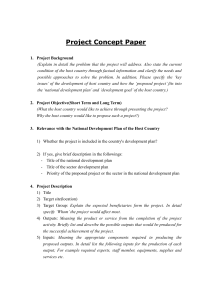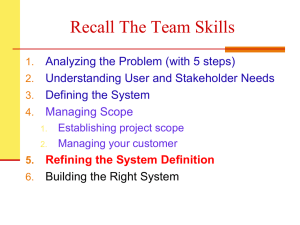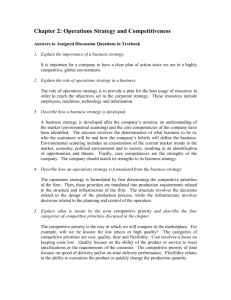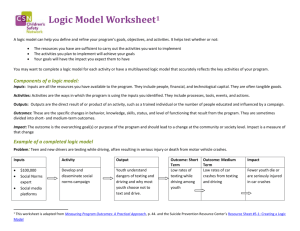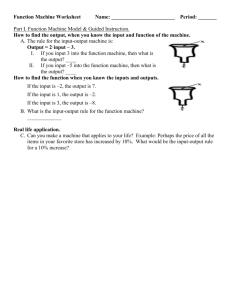glossary - Cengage Learning
advertisement
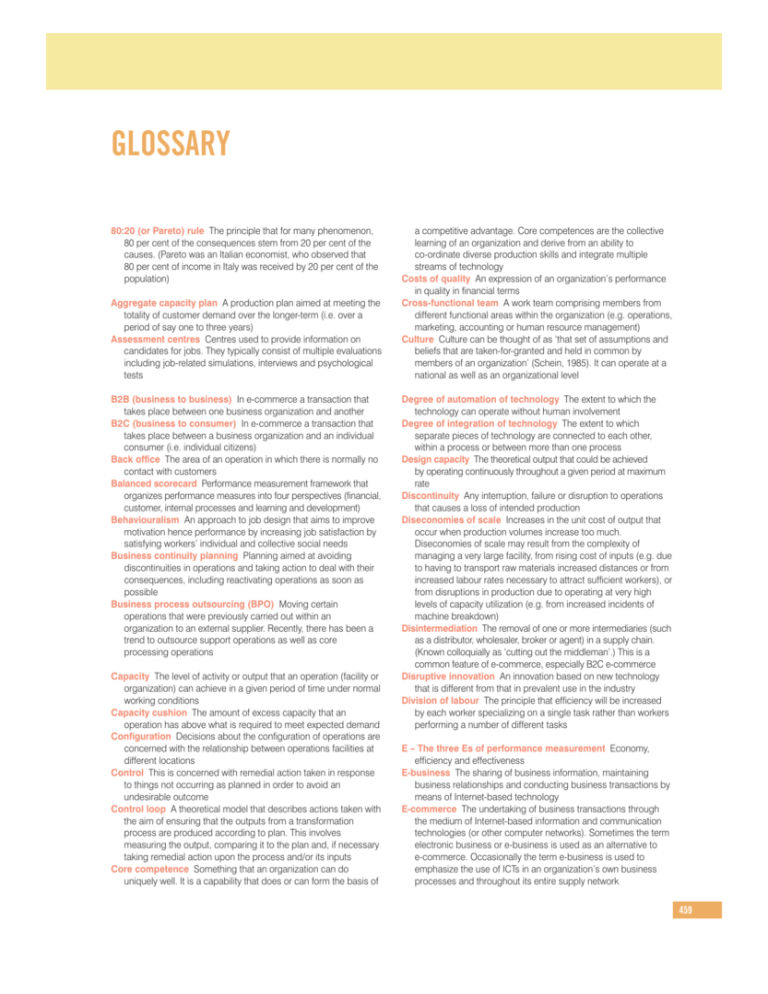
GLOSSARY 80:20 (or Pareto) rule The principle that for many phenomenon, 80 per cent of the consequences stem from 20 per cent of the causes. (Pareto was an Italian economist, who observed that 80 per cent of income in Italy was received by 20 per cent of the population) Aggregate capacity plan A production plan aimed at meeting the totality of customer demand over the longer-term (i.e. over a period of say one to three years) Assessment centres Centres used to provide information on candidates for jobs. They typically consist of multiple evaluations including job-related simulations, interviews and psychological tests B2B (business to business) In e-commerce a transaction that takes place between one business organization and another B2C (business to consumer) In e-commerce a transaction that takes place between a business organization and an individual consumer (i.e. individual citizens) Back office The area of an operation in which there is normally no contact with customers Balanced scorecard Performance measurement framework that organizes performance measures into four perspectives (financial, customer, internal processes and learning and development) Behaviouralism An approach to job design that aims to improve motivation hence performance by increasing job satisfaction by satisfying workers’ individual and collective social needs Business continuity planning Planning aimed at avoiding discontinuities in operations and taking action to deal with their consequences, including reactivating operations as soon as possible Business process outsourcing (BPO) Moving certain operations that were previously carried out within an organization to an external supplier. Recently, there has been a trend to outsource support operations as well as core processing operations Capacity The level of activity or output that an operation (facility or organization) can achieve in a given period of time under normal working conditions Capacity cushion The amount of excess capacity that an operation has above what is required to meet expected demand Configuration Decisions about the configuration of operations are concerned with the relationship between operations facilities at different locations Control This is concerned with remedial action taken in response to things not occurring as planned in order to avoid an undesirable outcome Control loop A theoretical model that describes actions taken with the aim of ensuring that the outputs from a transformation process are produced according to plan. This involves measuring the output, comparing it to the plan and, if necessary taking remedial action upon the process and/or its inputs Core competence Something that an organization can do uniquely well. It is a capability that does or can form the basis of a competitive advantage. Core competences are the collective learning of an organization and derive from an ability to co-ordinate diverse production skills and integrate multiple streams of technology Costs of quality An expression of an organization’s performance in quality in financial terms Cross-functional team A work team comprising members from different functional areas within the organization (e.g. operations, marketing, accounting or human resource management) Culture Culture can be thought of as ‘that set of assumptions and beliefs that are taken-for-granted and held in common by members of an organization’ (Schein, 1985). It can operate at a national as well as an organizational level Degree of automation of technology The extent to which the technology can operate without human involvement Degree of integration of technology The extent to which separate pieces of technology are connected to each other, within a process or between more than one process Design capacity The theoretical output that could be achieved by operating continuously throughout a given period at maximum rate Discontinuity Any interruption, failure or disruption to operations that causes a loss of intended production Diseconomies of scale Increases in the unit cost of output that occur when production volumes increase too much. Diseconomies of scale may result from the complexity of managing a very large facility, from rising cost of inputs (e.g. due to having to transport raw materials increased distances or from increased labour rates necessary to attract sufficient workers), or from disruptions in production due to operating at very high levels of capacity utilization (e.g. from increased incidents of machine breakdown) Disintermediation The removal of one or more intermediaries (such as a distributor, wholesaler, broker or agent) in a supply chain. (Known colloquially as ‘cutting out the middleman’.) This is a common feature of e-commerce, especially B2C e-commerce Disruptive innovation An innovation based on new technology that is different from that in prevalent use in the industry Division of labour The principle that efficiency will be increased by each worker specializing on a single task rather than workers performing a number of different tasks E – The three Es of performance measurement Economy, efficiency and effectiveness E-business The sharing of business information, maintaining business relationships and conducting business transactions by means of Internet-based technology E-commerce The undertaking of business transactions through the medium of Internet-based information and communication technologies (or other computer networks). Sometimes the term electronic business or e-business is used as an alternative to e-commerce. Occasionally the term e-business is used to emphasize the use of ICTs in an organization’s own business processes and throughout its entire supply network 459 460 GLOSSARY E-learning The term used to describe the use of web-based learning Economies of scale Reductions in unit cost of output due to increasing production volumes. Unit costs savings are achieved by spreading the fixed costs of production over an increased volume and from the increased efficiency available from the division of labour and from using large-scale machinery Economies of scope Reductions in unit costs available from increasing the number of products produced. Unit costs savings are achieved by spreading certain overhead costs (such as administration, distribution, marketing, etc.) over an increased volume of output, assuming that these costs do not increase as a result of increasing the number of products EDI (electronic data interchange) The computer-to-computer exchange of structured information via a telecommunication link. EDI has been used by business since the 1970s and there are agreed international standards covering its use. It is still used by many MNEs to automate their purchase of goods and services Effective capacity The output achievable in a given period after the deduction of output lost due to planned stoppages Effectiveness A measure of the success of an operation in producing outputs that satisfy customers Efficiency A measure of the success of an operation in converting inputs to outputs Empowerment The concept that workers are given greater control over the work that they do, without reference to higher levels of management Enterprise resource planning (ERP) A computer-based system for resource planning and control across an entire organization. ERP is suitable for any type of business, services as well as manufacturing, and not for profit as well as profit seeking organizations Expatriate (expat) A person temporarily or permanently working in a country other than their home country Failure mode and effects analysis (FMEA) A technique used to identify likely causes of failure and their consequences so that preventative actions can be taken Focused operations Based on Skinner’s (1974) idea of a ‘focused factory’, this is the notion that a facility that concentrates on a single or very narrow range of tasks will outperform one trying to achieve a broader range of tasks. Focus might be achieved by limiting the markets served, the products produced or processes used at a particular facility Forecasting The act of predicting the future likely level of demand for products and services. Forecasting methods can be either quantitative or qualitative Front office The area of an operation in which contact with customers normally takes place Globalization This refers to the increasing integration of economic activity around the world, evidenced by the growth in international trade and the increasing interdependence of national economies. An increase in cross-border social, cultural and technological exchange is also a feature of globalization. Critics of globalization claim it gives too much power to free market economics and multi-national enterprises and has detrimental effects on less developed countries and the environment Gross domestic product (GDP) A measure of the size of a country’s economy. It is defined as the market value of all final goods and services produced within the country Groupthink The phenomenon in which the desire for consensus leads a group to make bad or irrational decisions which members might otherwise individually consider to be unwise Host country national (HCN) A worker from the country of the subsidiary Human resources The people that work for an organization Internationalization The process of expanding business operations across international boundaries. At first this might only involve exporting or importing goods and/or services. But it might go on to involve the establishment of production facilities in other countries, as well as facilities to support sales, R & D, and other activities in foreign countries Job description This outlines the duties and responsibilities required for a particular job or position Job design The process of specifying the methods used by people performing work tasks and particularly the way that they interface with the technology they use Just in time (or JIT) A manufacturing system that aims to produce only what is required, in the quantity that is required, at the time it is required Knowledge management The study of how organizations gather and use knowledge in order to add value in their operations and create a competitive advantage Lean production An alternative name for just in time Lean thinking The application of just in time principles to nonmanufacturing organizations Less developed country (LDC) A country whose economy is under developed, relying mostly on agriculture (and possibly extractive industries), and whose population has a low standard of living Manufacturing resources planning (MRP2) A computer-based system of planning and control for manufacturing processes that extends MRP to include all manufacturing resources and links the software for manufacturing planning and control to that for all other functions of the organization via an integrated database Market access strategy A strategy in which operations are internationalized in order to access and serve markets outside of the home country Mass customization The use of a single process to produce a wide variety of products (or services). It aims to realize unit cost reductions through economies of scope in the same way that mass manufacturing aims to achieve economies of scale Materials requirement planning (MRP) A computer-based system of calculating the quantities and timings of materials required for dependent demand items in a manufacturing process Measures of economy Measures concerned with the cost of the goods and services required as inputs for the operations process Measures of effectiveness Measures concerned with the extent to which the outputs of a process meet the requirements of its customers Measures of efficiency Measures concerned with the performance of the transformation process itself, in terms of its ability to make optimum use of resource inputs in the creation of outputs GLOSSARY Multi-national enterprise (MNE) Sometimes also termed a multinational company (MNC), this is a business organization that has operations in a number of different countries Network perspective This perspective argues that it is necessary to consider all of an organization’s facilities collectively in order to realize their full potential to serve all their customers irrespective of their geographic location New product development The term used to describe all those activities directed towards the introduction of new or improved products or services into the market place Newly industrialized economy (NIE) Sometimes also termed a newly industrialized country (NIC), this is a country which has undergone a considerable level of industrialization in the recent past, switching its primary economic activity from agriculture to manufacturing, and possibly services. NIEs are not quite yet at the status of the industrialized nations of the West, but are more advanced than the countries of the third world Off-shoring Moving certain operations to another county. This could be done either by relocating the affected operations to the organization’s own facilities in another country, or by outsourcing the operations to a foreign supplier. The motivation for this is often, but not exclusively, cost saving Operations facility A collection of resources brought together at one geographic location for the purpose of producing particular goods and/or services Operations function That part of the organization that has the responsibility for operations management Operations management This is concerned with the management of the resources and processes required by an organization to produce goods or services for customers Operations performance objective A criterion against which to evaluate the performance of operations. There are considered to be five possible operations performance objectives: cost, quality, speed, dependability and flexibility Operations strategy This concerns the pattern of strategic decisions and actions which set the role, objectives and activities of operations (Slack et al., 2004) Order point systems Inventory control systems for independent demand items that aim to determine when and how much to order from suppliers to ensure that stocks do not run out Outsourcing One of the terms used to describe the process of obtaining inputs of goods or services from a source outside of the organization Parent county national (PCN) Also termed an expatriate, an employee sent from an organization to work in a subsidiary based in another country Performance measurement The process of quantifying the efficiency and effectiveness of actions Performance measurement system A collection of performance measures used by an organization to assess the performance of various aspects of its activities Performance standard The level of performance deemed suitable for use as the target level of performance against which to compare a particular aspect of performance Person specification A list of the knowledge, experience and skills necessary for a person to be able to perform a particular job Planning This is concerned with actions taken prior to an event, typically arranging for resources to be provided in order to achieve a desired outcome 461 Process technologies The tools (equipment, machines and other devices) used in operations that transform materials, information or customers Psychometric tests Written tests that assess a person’s aptitude and personality in a measured and structured way. Such tests are often used by employers as part of their recruitment and selection processes Quality assurance This involves taking a proactive approach towards quality management by seeking to prevent defects ever being produced. This usually involves the adoption of a quality management system Quality circle A group of workers who come together to solve quality and other related problems within their work area Quality control An extension of quality inspection in that it uses data from inspection to identify causes of defects and to take corrective action Quality function deployment (QFD) A structured procedure that aims to ensure that the design of products and services meets the needs of the customer. (QFD is sometimes also referred to as the voice of the customer.) It does so by forcing designers to match each customer requirement of the product with the way that the design meets that requirement. (QFD is sometimes also referred to as the house of quality) Quality gap Any difference between customers’ expectations of a product or service and their perceptions of their experience of it Quality inspection The inspection and testing of the outputs from a transformation process to determine whether they are of saleable quality or if they should be rejected, reworked or downgraded for sale as ‘seconds’, normally at a lower price Quality management system (QMS) A systematic approach to proactively managing quality based on documented standards and operating procedures. The best known QMSs are those based on the ISO9000 series of quality standards Queuing theory The mathematical study of waiting lines Re-intermediation The reintroduction of an intermediary in a supply chain. The growth of e-commerce has prompted the emergence of new kinds of intermediary in many industries Resource seeking strategy A strategy in which operations are internationalized in order to access and serve markets outside of the home country Scale Decisions about the scale of operations are concerned with what quantities of goods and services should be produced at any given facility Scale of technology The processing capacity of a type of technology (rather than its physical size) Scientific management A management led approach to job design that seeks to establish the best way of performing any task through a process of disaggregation and routinization, using methods such as work study Scope Decisions about the scope of operations are concerned with what types of goods and services should be produced at any given facility Self-managed work team Work team in which workers are empowered to take many of the decisions concerning their work without reference to management Services The intangible outputs from an operation Statistical quality control (SQC) The application of statistics to the management of quality 462 GLOSSARY Strategy The direction and scope of an organization over the long-term, which achieves advantage in a changing environment through its configuration of resources with the aim of fulfilling stakeholder expectations (Johnson et al., 2005) Structure The structure of an organization is the way in which employees are formally divided into groups for co-ordination and control Supply chain Alternative term for a supply network Supply network The set of interconnected relationships between all the parties that supply inputs to, and receive outputs from an operation (including the suppliers’ suppliers and their suppliers etc. And the customers’ customers and their customers etc.) Sustaining innovation An innovation based on the use of technology whose use is prevalent in the industry Theory Z The term coined by Ouchi (1981) to describe the management style characteristic of many Japanese companies that combines various aspects of scientific management and behaviouralism. The term Theory Z is an attempt to associate this style with McGregor’s Theory X and Theory Y construct Third country national (TCN) A worker from a country other than the parent or host country Three Es of performance measurement Economy, efficiency and effectiveness Tier 1 supplier An immediate supplier to an organization, one that supplies directly to the organization. A tier 2 supplier supplies to a tier 1 supplier, and so on. The concept of tiers can also be applied to customers in the supply network. A tier 1 customer is one that is supplied directly from the organization’s operations Time to market The length of time taken to bring a new product to market. It is usually taken as the time from deciding to develop a new product to its market launch Total quality management (TQM) A philosophy for quality improvement based on principles of the elimination of waste, continuous involvement and the involvement of all employees Trade-off The concept based on the premise that it is impossible to excel simultaneously at all aspects of operations. This means that an operations strategy can only be successful if it is based upon a single clear goal, determined by a prioritization of operations performance objectives (e.g. cost, quality, speed, dependability and flexibility) Transformation process The system by which inputs of resources (e.g. people, equipment, materials, energy, information) are converted into outputs of goods and services Vertical integration The extent to which an organization owns the operations of the suppliers and customers within its supply network Work centre A collection of resources (people, machines, etc.) assembled together to undertake specific work tasks Work team A group of people who work together on a common task to achieve a specific goal or objective Yield management A set of techniques aimed at maximizing income from customer service operations




